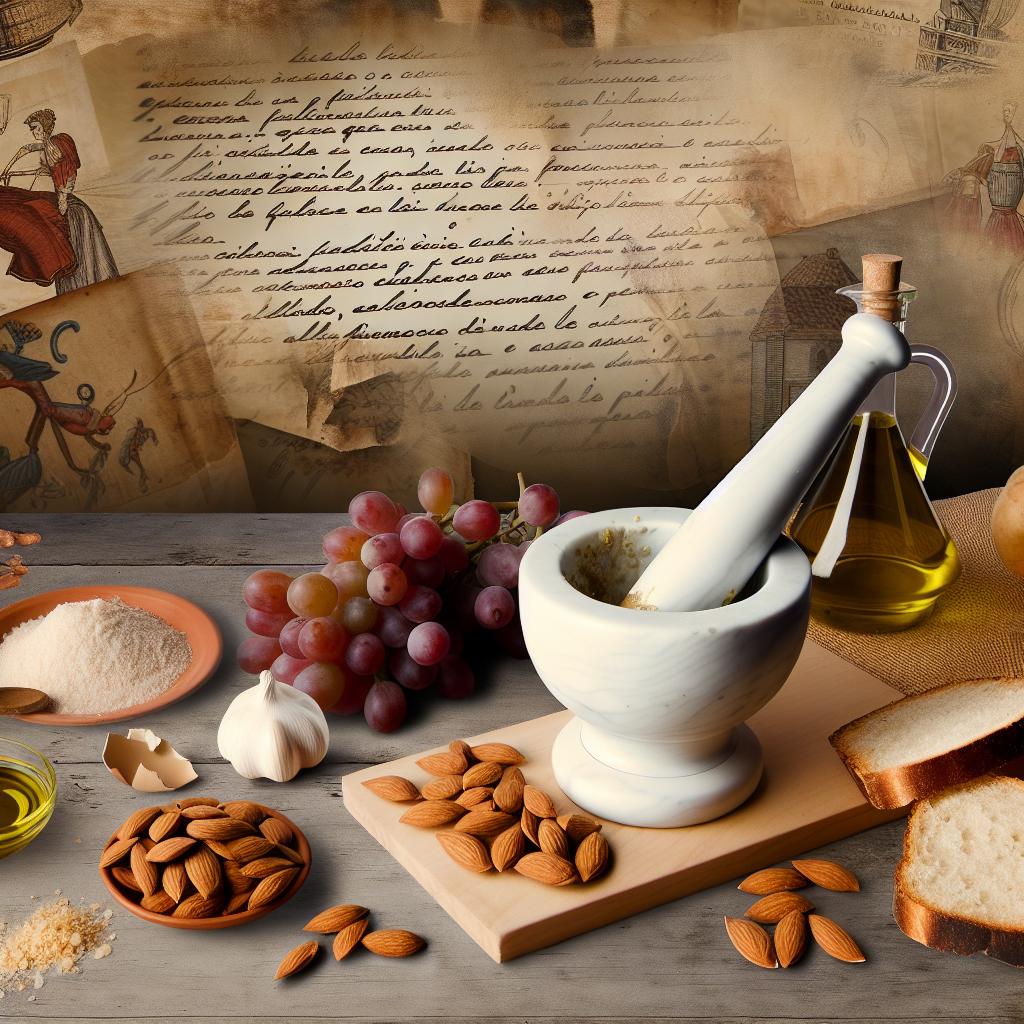
Ajo Blanco is a classic Spanish dish with roots that delve deep into the history of Andalusia, a region renowned for its rich and diverse culinary heritage. This cold garlic soup is often overshadowed by its more famous cousin, gazpacho, yet it stands out for its unique combination of flavors and ingredients that reflect the resourcefulness of the region’s historical inhabitants.
The creation of Ajo Blanco is often attributed to the influence of ancient Roman and Moorish cultures in Southern Spain. The Romans introduced viticulture and olive cultivation, two components integral to the soup. Later, the Moors, who occupied the Iberian Peninsula for several centuries, brought almonds, further enriching the local gastronomy. These early contributions set the foundation for what would become one of Andalusia’s most beloved soups.
Traditionally, Ajo Blanco was a meal of the peasantry, crafted from easily accessible ingredients such as garlic, bread, and almonds. It was a sustenance meal, providing the necessary calories and nutrients for laborers working in the fields. The simplicity of its preparation allowed for it to be a staple among the rural communities of Andalusia. Over the centuries, the recipe evolved, absorbing new ingredients and techniques, yet it retained its fundamental character.
The Evolution of Ingredients:
The advent of trade and improved agricultural practices brought garlic, olive oil, and vinegar, which became essential elements of the soup. The incorporation of these ingredients showcases the adaptation of local culinary practices in response to broader cultural and economic changes. Furthermore, as spices and exotic foods arrived in Spain during the Age of Exploration, Ajo Blanco began to absorb subtle influences from these new gastronomy trends, albeit sparingly to retain its essence.
Preparation Techniques:
Traditional preparation methods involved manual grinding of the ingredients using a mortar and pestle, a practice that ensured the flavors melded together seamlessly. This manual process not only highlights the dish’s rustic origins but also emphasizes the communal aspect of food preparation, where families would gather to create and enjoy this simple yet delightful dish.
Today, Ajo Blanco is enjoyed as a refreshing dish, particularly popular in the hot summers of southern Spain. Modern adaptations sometimes include a variety of garnishes like grapes or melon to add a hint of sweetness and texture contrast. Despite these modern twists, the core of the dish remains unchanged, honoring its humble origins.
Contemporary Culinary Scene:
In the contemporary culinary scene, chefs often experiment with Ajo Blanco, introducing modern methods of preparation such as using blenders for a smoother consistency. The inclusion of seasonal fruits or seafood as toppings has become popular, thereby drawing a new audience to this traditional dish.
Restaurant Resonance:
Restaurants in Andalusia and across Spain pride themselves on offering traditional Ajo Blanco, each with their unique spin. This dish is often highlighted in seasonal menus, especially during the sweltering summer months. Patrons appreciate not only its refreshing qualities but also its historical significance as they indulge in flavors that have been appreciated for generations.
Ajo Blanco is more than just a culinary tradition; it is a symbol of cultural identity and resilience. It represents a sophisticated simplicity, where each ingredient plays a crucial role in achieving a harmonious flavor profile. Exploring this age-old recipe provides insight into the communal and adaptive nature of Andalusian cuisine.
Symbol of Resilience:
The enduring popularity of Ajo Blanco is a testament to the resourcefulness and adaptability of the Andalusian people. Throughout history, these communities have weathered numerous changes, yet they have preserved their culinary heritage with pride. Ajo Blanco serves as a culinary representation of perseverance and continuity amidst change.
Culinary Heritage:
Beyond its taste and nutritional value, Ajo Blanco is deeply woven into the cultural fabric of Andalusia. It forms part of local festivals and celebrations, where it is often served in communal settings, reinforcing bonds among villagers and visitors alike. Through such traditions, the cultural importance of Ajo Blanco is passed down through generations.
To learn more about the cultural significance of Andalusian dishes, you may explore resources such as Andalucia.com, which offers detailed insights into the region’s history and food.
Conclusion:
Ajo Blanco’s journey from a humble peasant dish to a celebrated culinary treasure is a narrative that encapsulates the history and cultural evolution of Andalusia. It is a dish that not only tantalizes the palate but also invites diners to partake in a rich historical and cultural journey. Whether enjoyed at a family gathering or a modern restaurant, Ajo Blanco continues to be a cherished representation of Andalusian heritage, inviting all who partake to savor a taste of history.
As one delves deeper into the realms of Southern Spanish cuisine, Ajo Blanco stands as a delicious reminder of the intricate tapestry of flavors and histories that come together in every bowl.